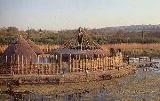Prehistoric Sites in Ireland.Irish Prehistoric Sites.Irish Megaliths. |
||
| |
Introduction. |
||
|
There is hardly a town land in the island of Ireland
that doesn't have an ancient monument of some kind, the total number catalogued
must be colossal. And of course there must have been many thousands It isn't quite clear when the first settlers arrived here, after the last Ice age with the ice sheets receding, opportunities were being created for ever resourceful Homo erecteus
For academic purposes the archaeological
worldhas divided our past into periods of time each of which posses
a characteristic range of artefacts and monuments left behind by each
successive community. These periods are:
During each period, humans have continuously evolved and as they progressed, new technologies and breakthroughs resulted in the creation of new artifacts and monuments which in their own way stand as a The Early Stone Age. The New Stone Age Around 4,000 BC, society evolved from hunter gatherer
|
||
|
|

